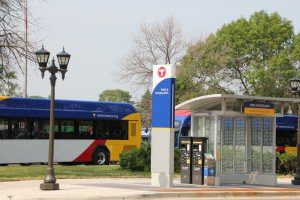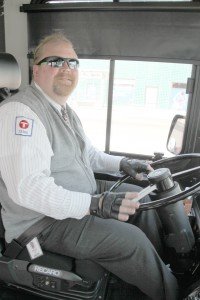By TESHA M. CHRISTENSEN
A Line buses are rolling between the 46th St. light rail station in Minneapolis and Snelling Ave. in St. Paul, offering residents a quicker, more convenient ride.
The Twin Cities’ first arterial bus rapid transit (BRT) line officially opened on June 11 with a ribbon-cutting and free bus rides.
 Photo right: The path of the new A Line travels down Snelling Ave. from Rosedale Mall to Highland Park and over to the 46th St. Station along Hiawatha in Minneapolis. Along the way it links Rosedale Mall to both of the Twin Cities light rail lines, the planned soccer stadium near University, and future redevelopment at the decommissioned Ford Plant. Through the first week of operation, the A Line provided 30,308 rides. Combined with the still existing 84 route, there were 36,205 rides given in the first week, a 36% increase. (Photo by Tesha M. Christensen)
Photo right: The path of the new A Line travels down Snelling Ave. from Rosedale Mall to Highland Park and over to the 46th St. Station along Hiawatha in Minneapolis. Along the way it links Rosedale Mall to both of the Twin Cities light rail lines, the planned soccer stadium near University, and future redevelopment at the decommissioned Ford Plant. Through the first week of operation, the A Line provided 30,308 rides. Combined with the still existing 84 route, there were 36,205 rides given in the first week, a 36% increase. (Photo by Tesha M. Christensen)
The A Line will offer a new kind of bus service that will cut the journey from 46th St. Station to Rosedale Mall from 48 minutes to 35 minutes.
While only a small portion of the $27 million A Line operates within the city of Minneapolis, “the impacts of this line are anything but small for this region,” stated Peter Wagenius of Mayor Betsy Hodges’ office.
“The connectivity to St. Paul for South Minneapolis residents will be much enhanced,” remarked Hennepin County District 4 Commissioner Peter McLaughlin.
 Photo left: Hennepin County District 4 Commissioner Peter McLaughlin (center) rides on the new A Line. Following the press conference on Fri., June 10, McLaughlin connected to the Green Line for a meeting in St. Paul. He’s excited about how the A Line will make it easier for himself and other South Minneapolis residents to get to downtown St. Paul via the connection with the Green Line light rail at University and Snelling, as well as the shorter journey over to Highland Park where he shops and holds a gym membership. (Photo by Tesha M. Christensen)
Photo left: Hennepin County District 4 Commissioner Peter McLaughlin (center) rides on the new A Line. Following the press conference on Fri., June 10, McLaughlin connected to the Green Line for a meeting in St. Paul. He’s excited about how the A Line will make it easier for himself and other South Minneapolis residents to get to downtown St. Paul via the connection with the Green Line light rail at University and Snelling, as well as the shorter journey over to Highland Park where he shops and holds a gym membership. (Photo by Tesha M. Christensen)
McLaughlin pointed out St. Paul residents will be able to get to the airport without driving, lessening the traffic and pollution load. And Minneapolis residents can use the A Line to shop in Highland Park, as well as to connect with the Green Line on their way to downtown St. Paul.
The BRT system is helping to fill in the transportation web in the Twin Cities and making it a fuller system, McLaughlin observed. “We’re starting one line at a time, building the system out.”
McLaughlin added, “The more connections you have that are reliable and affordable, the more riders you will have.”
The A Line is the first of 15 routes that will travel along high-use corridors. The next planned is the C Line, which will link Brooklyn Center to downtown Minneapolis down Penn Ave. The C Line, initially set to start construction next year, was pushed back to 2018 due to a $15 million funding gap.
Designed by and for customers
“This is a unique service because it really was designed by and for our customers,” pointed out Metro Transit General Manager Brian Lamb during a press conference in Highland Park on June 10.
Customers said they wanted faster speeds and better amenities with more predictability. The A Line has 40-foot Gillig model buses with low floors, wider bus doors and boarding from any door.
 Photo left: South Metro bus driver and trainer Brian Hanson is excited to see the A Line begin rolling down Snelling. “I love it,” Hanson said. (Photo by Tesha M. Christensen)
Photo left: South Metro bus driver and trainer Brian Hanson is excited to see the A Line begin rolling down Snelling. “I love it,” Hanson said. (Photo by Tesha M. Christensen)
Real-time NexTrip displays tell customers just how long a wait to expect. Other amenities include heated shelters, security cameras, bike racks and WiFi.
Customers pay their fares at ticket vending machines prior to boarding the bus, and can transfer easily between regular bus routes and light rail.
Buses remain in the right driving lane as they board passengers to save time, thanks to extended curbs at stations, although this feature has some residents concerned about impacts on traffic.
The A Line buses will stop at fewer red lights courtesy of transit signal priority at 19 of the 34 signals along the line.
The Metro Transit system pulled together the best of what other cities offer, and tailored it to fit the needs of Minnesotans, according to Metro Transit BRT Project Manager Katie Roth.
“This is going to show how when we, as Legislators, embrace the leadership of local communities, we can do well by them,” remarked State Senator Scott Dibble, who chairs the Transportation and Public Safety Committee.
Great regions need great transportation systems
The Twin Cities area is expected to grow by 80,000 people in the next few decades, Dibble pointed out. “We have to provide choices and options, and deliver the quality of life to make this a viable, vibrant, competitive metropolitan area,” he said.
St. Paul Mayor Chris Coleman agreed that great regions need great transportation systems. Development opportunities, such as the 20,000-seat Midway soccer stadium and 34.5-acre mixed-use development, are possible because of the investments already made in transportation infrastructure.
“This area will fully develop because we have transportation investments like the A Line,” stated Coleman.
“The A Line is going to make commuting more convenient for thousands of people,” stated Lieutenant Governor Tina Smith. She expects to see the line support jobs and economic development in the region.
Midway Chamber of Commerce Board Chair Ted Davis has seen the area transformed by the Green Line. He is excited by what the A Line means for businesses.
“Investments like this mean jobs and economic development,” said Davis. “The cities that thrive are the cities that have safe, comfortable, affordable, reliable transit that makes it easier for employers to hire the people they need.”
Predictable route will attract more riders
When Minnesota Department of Transportation Commissioner Charlie Zelle went to high school, he knew every curb cut along Snelling during his daily bus ride. He told those gathered on June 10 that he can’t think of a more fitting roadway than Snelling Ave. for the start of the urban Bus Rapid Transit system. Zelle believes that the predictability of the route will attract more riders.
The 10-mile A Line is now the primary bus route serving Snelling Ave. and Ford Pkwy. with increased service in evenings and on weekends, substantially replacing much of Route 84.
The span of service is very similar to the old Route 84 schedule, with trips beginning at approximately 4am and continuing until approximately 1:30am.
The A Line operates every 10 minutes along the 9.7-mile-long route during rush hours, midday, evenings, and weekends, with less frequent service in the early morning and late at night.
The new BRT line pulls together four communities: Minneapolis, St. Paul, Falcon Heights, and Roseville.
The path travels down Snelling Ave. from Rosedale Mall to Highland Park and over to the 46th St. Station along Hiawatha in Minneapolis. Along the way it links Rosedale Mall to both of the Twin Cities light rail lines, the planned soccer stadium near University, and future redevelopment at the decommissioned Ford Plant.
It passes several colleges, offering students a quicker way to travel. Seventy-five percent of the people who ride the bus use it to get to school or work, noted Lamb.
Hamline University President Dr. Fayneese Miller views the A Line as a vital new resource for Hamline students, and pointed out that it will not only help students get to campus but enable them to be active in the local community.
“Not only will you have our service, but you will also have our brain power,” promised Miller.
Comments
No comments on this item Please log in to comment by clicking here